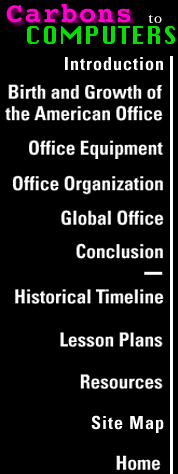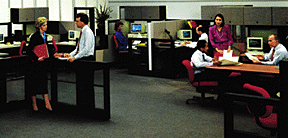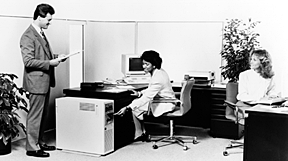
Offices Today
Today's workplace design is no longer dictated by the product or service produced; nor is it a matter of "looking good." Rather, it is driven by increased competition, rapid technological advances, and shifts in working styles. In the 1990s, functionality based on the actual process of work seems more important than corporate image.
Increased competition and shrinking profits have forced corporate America to slim down. The 1990s workplace has become lean and mean, opting for smaller and less private spaces and more powerful, versatile technology. The walls are tumbling down: Managers and even some CEOs who once presided over their employees in large, private, wood-paneled offices have moved onto "the floor," joining their subordinates in a maze of cubicles meant to foster equality, increased communication, and teamwork.

The "office landscape" concept, which was introduced in the early 1960s, dictates that workspaces should be organized to reflect the flow of information and communication patterns. More than thirty years later, an estimated forty million Americans, nearly 60 percent of the white-collar workforce, work in cubicles. Modern corporate management is learning to adapt to a new business culture in which teamwork and communication are becoming much more important to worker productivity.
Smaller workspaces also save corporations money. Rising real estate, utilities, and equipment costs have forced many companies to review their bottom lines and to reconsider where they put their shrinking resources. Whereas it was once important to have impressive offices--which was often intended to inspire confidence in a company's prestige and "staying power" the current trend is toward modest facilities, which are thought to foster a perception of cost consciousness.
The corporate reality may differ from the perception, however. Despite the physical changes in the modern office, inequalities in rank, talent, and pay still exist in the workplace. And for some offices, the changes may simply represent what management would like workers and customers to believe about the company.
Not everyone appreciates the office cubicle culture. Some workers feel uncomfortable without doors that they can close, and although communication between colleagues may rise, so do distractions. Certain specialized workers whose tasks require focused concentration might be particularly sensitive to the distractions that often exist in the cubicle culture, preferring to work in private offices.
Technology, too, has had a significant impact on the design of the workplace. Desktop computers have replaced typewriters, adding machines, and file cabinets. E-mail and voice mail have all but eliminated the stackable "in-box" and telephone message slips. Fewer offices maintain onsite libraries and publications departments, opting instead for online databases and desktop publishing. The result is lower overhead, less clutter, and higher worker productivity.
Many office computers are linked together through local area networks (LANs), enabling employees to share files and resources. Many of these desktop systems are networked with other offices via intranets and with systems around the world via the Internet. Networking fosters rapid communication, enables collaboration among workers regardless of geography, and permits access to the wealth of information posted on the World Wide Web.
Changes in society, such as a more mobile workforce and workers' demands for flexibility, have fueled the development of portable office equipment. Laptop computers, cellular phones, and facsimile machines now equip a growing telecommuting workforce and, in some cases, have eliminated the need for central offices altogether. The option of telecommuting has become a valuable tool for companies competing for skilled employees who are tired of commuting long distances from the suburbs.
In addition, the ready supply of independent contractors, many of whom maintain fully equipped home offices, has enabled many businesses to employ freelancers for certain tasks that previously would have required hiring more staff and purchasing specialized equipment. The cost savings for many of these companies can be substantial.
Offices of the future will likely continue to tailor the physical conditions of workers to the work being done, with more focus on the work "process." Office technology will continue to evolve toward more versatile and compatible systems in response to global information demands and more complex data management tasks.
